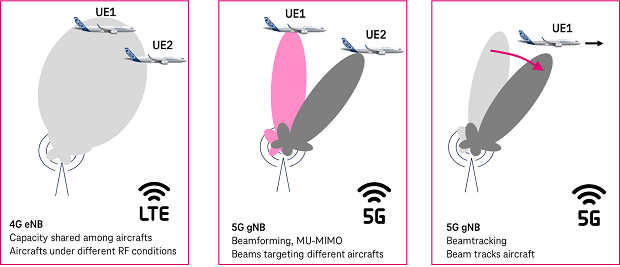EAN’s 5G Evolution
Our European Aviation Network (EAN) inflight broadband solution is currently based on 4G (LTE) technology, but as mentioned within the previous article from our EAN Tech Update Series, we have been working on a roadmap towards 5G, which will enhance capacity, performance and the overall user experience for our customers, whilst also ensuring backwards compatibility for 4G services.
Of course, to truly benefit from potential service improvements, our roadmap planning needs to take into consideration the complete EAN end-to-end solution. This includes not only our network infrastructure, but also the compatibility of onboard equipment and securing relevant spectrum licenses to allow continued EAN commercial operation under 5G technology. Here, we focus on the first piece of this puzzle; our award-winning CGC (Complementary Ground Component) network.
EAN’s 5G migration path
For this critical element of our EAN service, we have selected a migration path for 5G deployment from two available options: a standalone (SA) option, which consists of only one generation of radio access technology (5G), and a non-standalone (NSA) option, which consists of two generations of radio access technologies (4G LTE and 5G). For NSA deployment, LTE and 5G radio network are connected to an existing core (EPC). This means that legacy 4G deployments will be supported, while 5G deployments only need to support the new radio (NR) 5G air interface. For us, the obvious choice was the NSA approach.
Why? The airline industry traditionally has life cycles of 10 years or more, while the Telco business sees major upgrades every 5 years. With the NSA approach, we can continue to support existing aircraft fleets with a 4G configuration, while carefully deploying a fully 5G compatible system. The same approach will also allow us to make an offer to potential airline customers at any stage of our rollout phase. In other words, all adopters of our EAN service can rest assured that they will receive a strong performing connectivity service throughout the aircraft lifetime.
Once the onboard equipment needed for EAN to support this 5G technology is available, airline customers will have the flexibility to phase their transition to the 5G compatible network via this intermediate hybrid 4G/5G step. When future aircraft fleet rollouts will be kitted out directly with the next generation solutions, we can offer the possibility to rely on 5G only. Consequently, the return of invest and maturity of existing installations is supported while facilitating a smooth but also fast migration path to 5G.
Covering longer distances
With the more flexible frame design of 5G, we expect even longer distances to be covered between ground antennas and aircraft, as today’s upper limit is not necessarily a response to signal path loss over distance, but more due to 4G timing advance and protocol constraints. This translates to higher availability and better performance for the user even as it moves further away from the ground network antenna relative to what we are experiencing today.
These advanced ground network antenna systems will also pave the way for more capacity. Multi-User MIMO, which will come hand-in-hand with our 5G solution design, will allow scheduling of multiple aircrafts in the same resource grid simultaneously and beam tracking will ensure that the antenna main beam is directed straight to the location of a moving aircraft (see illustration).

Backed by a strong community
The strategic approach of EAN moving to 5G technology is backed by a strong community, ensuring economy of scales. Deutsche Telekom has an important voice within the standardization initiatives for 3GPP, and also has close supplier collaborations with dedicated EAN lab testing facilities in place. Finally, we are currently preparing several proof-of-concept (PoC) exercises as well as flight tests in support of these initiatives.
Compared to the initial ground network rollout of EAN, the upgrade towards 5G will also be much easier and faster as the same tower grid can be re-used. We can easily upgrade existing backhaul solutions, adapt our field-service support, and ensure spare part logistics are in place prior to launch. Our EAN regional workforce is available and already excited by the opportunity to jump on any extension plan without further lead time.
While this article concludes our EAN Tech Update Series, stay tuned for more news in the EAN 5G arena and other technological advancements. We stay committed; we won’t stop.
SOCIAL MEDIA